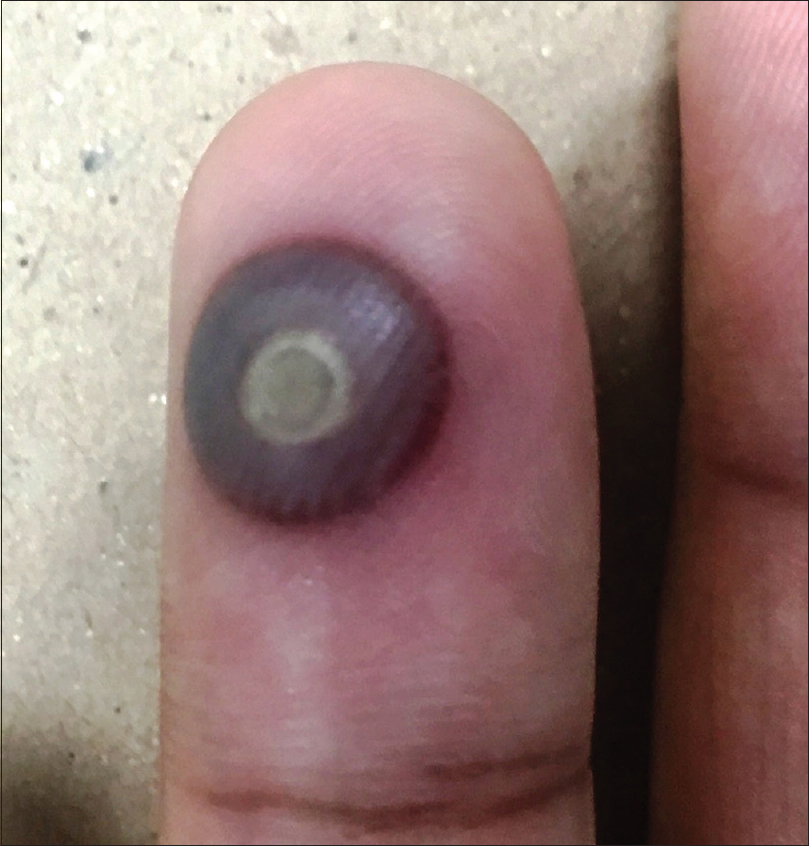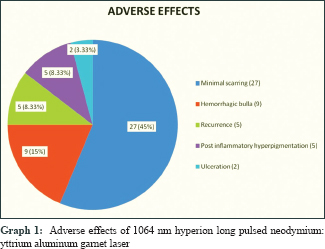Translate this page into:
A retrospective analysis of the therapeutic effectiveness of 1064nm long pulsed neodymium: yttrium aluminum garnet laser in common warts: An Indian study
Correspondence Address:
Manjunath Mala Shenoy
Department of Dermatology, Venereology and Leprosy, Yenepoya Medical College Hospital, Yenepoya (Deemed to be) University, Deralakatte, Mangalore - 575 018, Karnataka
India
| How to cite this article: Belman M, Shenoy MM, Vishal B, Pinto M, Hegde SP, Asfiya A. A retrospective analysis of the therapeutic effectiveness of 1064nm long pulsed neodymium: yttrium aluminum garnet laser in common warts: An Indian study. Indian J Dermatol Venereol Leprol 2020;86:730-733 |
Sir,
Warts are commonly encountered in clinical practice. Chemical cautery, keratolytics, cryotherapy, electrocautery, immunotherapy and lasers are its popular treatment options.
Carbon dioxide laser (CO2), pulsed dye laser (PDL) and long pulsed neodymium (Nd):yttrium aluminium garnet (YAG) laser have demonstrated varying rates of therapeutic success; their principle mode of action being photothermal or photomechanical destruction of target tissue. They provide better clearance rates and have lesser adverse effects than conventional therapies.[1] We failed to find any Indian study regarding long-pulsed Nd:YAG use in warts.
We analyzed the medical records of all patients with common warts presenting to the department of dermatology, Yenepoya Medical College Hospital, Deralakatte, Mangalore, who were treated with 1064 nm long-pulsed Nd:YAG, between May 2019 and July 2019. Demographic details, therapeutic response and adverse effects were recorded at each visit. These patients were followed up at 1 month and 3 months posttreatment. For assessment, therapeutic response was graded as: complete resolution (complete disappearance of lesion); partial resolution (partial disappearance with few remnants) and no resolution (lesion intact); adverse effects classified as: pain/hemorrhagic bulla/ulceration/secondary infection/post-inflammatory hyperpigmentation/scarring and recurrence (present/absent). We used the USFDA approved 1064nm Hyperion long pulsed Nd: YAG laser (Laseroptek Co. Ltd.), for treating common warts, with the following settings: fluence: 150 mJ/cm[2], on-time: 40 msec and spot size: 5 mm. We administered 2% lignocaine (sub cutaneous) prior to procedure. Entire area of warts was covered using 2-3 passes of slightly overlapping pulses of laser, including a single course of slightly overlapping pulse for 1mm perilesional normal skin.
We included 18 patients with 60 warts (M:F 12:6). Thirteen (72.22%) patients belonged to 21-30 year age-group, majority (61.11%) being students. Sixteen (88.89%) subjects were asymptomatic. Only 2 patients (11.11%) presented within the first month of appearance of verrucae [Table - 1]. In our study, lesions had a predilection for hands. Complete resolution occurred in 54 lesions (90%) at 1 month follow-up [Figure - 1] and [Figure - 2], while three (5%) lesions showed partial and no-resolution each [Figure - 2]. Overall, 27 lesions (45%) healed with minimal scarring [Figure - 2]b. Nine (15%) lesions developed hemorrhagic bulla 5-7 days after procedure [Figure - 3], and 5 (8.3%) lesions cleared with post-inflammatory hyperpigmentation. Only 2 lesions (3.33%) developed an ulcer following procedure, which healed over several weeks. We noted recurrence of 5 lesions at 3-month follow-up. (recurrence rate: 8.33%) [Table - 1] and [Graph 1].

 |
 |
 |
| Figure 3: Hemorrhagic bulla on 7th day |

Warts are a common cause of concern due to their unsightly appearance and infective nature. Several therapeutic modalities have been tried for this condition; however, none can be considered the gold standard. long-pulsed Nd:YAG targets haemoglobin (chromophore) within blood vessels of warts. It is easier and quicker to perform, does not produce fumes, has a lower recurrence rate, minimal adverse effects and good patient compliance while being equally effective as cryotherapy or electrocautery.[2] In our study, the rate of complete resolution with single sitting was around 90%. Minimal scarring, hemorrhagic bulla, post-inflammatory hyperpigmentation and ulceration were the notable adverse effects.
[Table - 2] summarises the studies concerning long-pulsed Nd:YAG use in warts.[3],[4],[5],[6],[7],[8] The largest study conducted by Hanet al (Korea) involved four sittings to treat verruca vulgaris in 369 patients.[3] They used higher laser parameters and achieved a higher clearance rate (96%) after one sitting, while post-procedure pain, transient numbness and hemorrhagic bulla were the reported adverse effects. They observed lower recurrence rate in comparison to our study, which may be attributed to more number of sittings. Kimura et al. noted a lower clearance rate (56%) than ours, which could be due to their exclusive inclusion of recalcitrant warts and difficult to treat locations.[4] Our experience in treating warts with long-pulsed Nd:YAG has been encouraging because of its utility in managing multiple warts in one sitting and easy accessibility of difficult areas like fingertips. Our study was limited by the small sample size and lack of a comparator group.

Therefore, long-pulsed Nd:YAG is a safe and effective treatment modality for verruca vulgaris with minimal adverse effects, better patient compliance and lesser downtime. As there is lack of Indian studies evaluating its benefit in common warts, further large-scale studies with comparator group are necessary, to assess its role in the Indian set-up and optimise the laser parameters for Indian skin. We recommend inclusion of long-pulsed Nd:YAG as one of the preferred therapies for warts if facilities are available.
Declaration of patient consent
The authors certify that they have obtained all appropriate patient consent forms. In the form, the patients have given their consent for their images and other clinical information to be reported in the journal. The patients understand that their names and initials will not be published and due efforts will be made to conceal their identity, but anonymity cannot be guaranteed.
Financial support and sponsorship
Nil.
Conflicts of interest
There are no conflicts of interest.
| 1. |
Nguyen J, Korta DZ, Chapman LW, Kelly KM. Laser treatment of nongenital verrucae: A systematic review. JAMA Dermatol 2016;152:1025-34.
[Google Scholar]
|
| 2. |
Hsu VM, Aldahan AS, Tsatalis JP, Perper M, Nouri K. Efficacy of Nd: YAG laser therapy for the treatment of verrucae: A literature review. Lasers Med Sci 2017;32:1207-11.
[Google Scholar]
|
| 3. |
Han TY, Lee JH, Lee CK, Ahn JY, Seo SJ, Hong CK. Long-pulsed Nd: YAG laser treatment of warts: Report on a series of 369 cases. J Korean Med Sci 2009;24:889-93.
[Google Scholar]
|
| 4. |
Kimura U, Takeuchi K, Kinoshita A, Takamori K, Suga Y. Long-pulsed 1064-nm neodymium: yttrium-aluminum-garnet laser treatment for refractory warts on hands and feet. J Dermatol 2014;41:252-7.
[Google Scholar]
|
| 5. |
Bingol UA, Cömert A, Cinar C. The overlapped triple circle pulse technique with Nd: YAG laser for refractory hand warts. Photomed Laser Surg 2015;33:338-42.
[Google Scholar]
|
| 6. |
Goldberg DJ, Beckford AN, Mourin A. Verruca vulgaris: Novel treatment with a 1064 nm Nd: YAG laser. J Cosmet Laser Ther 2015;17:116-9.
[Google Scholar]
|
| 7. |
Smith EA, Patel SB, Whiteley MS. Evaluating the success of Nd: YAG laser ablation in the treatment of recalcitrant verruca plantaris and a cautionary note about local anaesthesia on the plantar aspect of the foot. J Eur Acad Dermatol Venereol 2015;29:463-7.
[Google Scholar]
|
| 8. |
El-Mohamady AS, Mearag I, El-Khalawany M, Elshahed A, Shokeir H, Mahmoud A. Pulsed dye laser versus Nd: YAG laser in the treatment of plantar warts: A comparative study. Lasers Med Sci 2014;29:1111-6.
[Google Scholar]
|
Fulltext Views
4,351
PDF downloads
1,708





